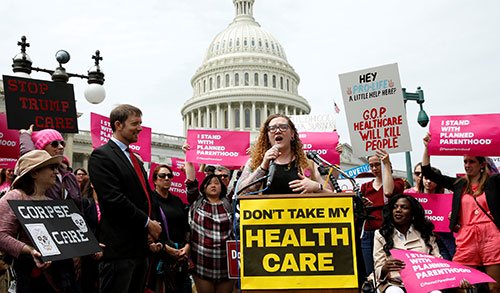
Longtime viewers of December NFL games may recall how a handful of then-special Saturday afternoons would feature at halftime the final stages of the “Punt, Pass, and Kick” competition among boys (and later girls) from ages 6 to 15. Regrettably, the league phased out that program in 2017.
However, a three-judge panel in the US Court of Appeals for the Fifth Circuit last Wednesday appeared to revive the judicial version of that skills competition in remanding the Texas v. United States case back to the United States District Court for the Northern Division of Texas, from whence it took on the grand ambition to declare the Affordable Care Act’s individual mandate unconstitutional and conclude that the rest of the entire ACA was not severable from that legal defect. Actually, only the majority ruling in the 2-1 decision did so; the dissenting judge would have dismissed the case for lack of standing, if not for other reasons if necessary. The controlling opinion by Judge Jennifer Elrod passed up the chance to end this litigation started in early 2018 by a group of Republican state attorneys general. It punted away the opportunity to determine the severability issue directly. And then it kicked the matter back to the federal district court judge who had previously overreached in deciding to overturn all enforcement of the health law that was enacted in 2010 and had already survived two previous challenges at the Supreme Court.
Let’s cut to the political bottom
line, before reviewing the legal merits of the decision in part 2. Although the
odds of the Texas v US plaintiffs actually winning eventually at the
Supreme Court in the next round looked grim, political time management may have
been an influential factor behind this latest decision. Whether one views it as
just running out the clock to avoid elevating difficult political issues for
ACA opponents during the 2020 election cycle, or going to overtime to hope for
a better result later, Republican incumbents and candidates dodged several
near-term bullets: either losing an appeal badly at SCOTUS by the end of June
2020, or failing to have a legislative solution to an unexpected victory there
that would require replacing most, if not all, ACA provisions under great
duress with little time to spare. In the meantime, a well-rehearsed echo chamber
of ACA supporters bewailing the imminent end of health care coverage,
regulation, and financing as they know it would be geared up to predict further
death, destruction, and chaos ahead. In other words, an amped-up replay of the
2018 congressional election period when Democratic gains were arguably driven
substantially by ads claiming that Republicans wanted to take away the ACA’s
protections against individuals with pre-existing health conditions losing, or
being unable to gain, insurance coverage.

Instead, there will be no reunion
party for the health law commentariat at the Supreme Court in 2020. Whether
district court judge Reed O’Connor gets the strong hint from the 5th Circuit
majority and pulls back his inseverability ruling, or chooses to butt heads
again upstream, there realistically is no time left on the normal appellate
calendar for the first half of 2020 (the remainder of the October 2019 term)
for any SCOTUS processing of a petition for certiorari, briefing, and oral
argument in this case, even if four justices had an appetite for considering
another Groundhog Day legal challenge to the ACA. And now they have the
perfectly respectable excuse to just wait and see how the remains of the case
proceed on remand to a lower court.
Consider also that in the unlikely
event that the original plaintiffs enjoyed a remarkable reversal of legal
fortune and climbed part-way back up the appellate ladder, the 2020 elections still
could inject a change in control of the federal Department of Justice legal
team that would upend further the unusual adversarial dynamics in the case.
(The Trump DOJ at first partly sided with the Republican state plaintiffs, then
switched over to support completely overturning the entire ACA, and then
belatedly adjusted to a more contorted stance of partial nonenforcement in some
states of some, but not all, ACA provisions. The tactical whiplash effects were
far from convincing!)
But in the meantime, both poles of
our hyper-exaggerated ACA policy disputes can recycle slightly altered versions
of their past claims of health policy Apocalypse or Rapture (closely linked,
though usually reversed, in biblical timing). ACA opponents can assert that the
individual mandate was ruled unconstitutional (again, albeit not yet at the
SCOTUS level), that the contorted tax-based saving construction of Chief
Justice Roberts in the 2012 NFIB case is running out of runway, and that the
severability kill shots will just take more time and tighter arguments (and
maybe a few more second-term Trump judicial nominations). On the other hand, rather
than boast that even several conservative Fifth Circuit judges could not buy
the full load of unconstitutional-ACA legal arguments, the loudest and most
persistent ACA supporters will prefer to warn of continuing dire threats ahead
to the Republic as long as some version of this case lives on!
Good times for all, plus more business for lawyers and legal commentators, if you’re willing to suspend disbelief further. Far more likely, the health policy world does not end, but existential ACA legal challenges do soon — not with a bang but with a whimper. As Roberto Duran put it in unceremoniously ending a 1980 fight with Sugar Ray Leonard, “No mas!” (Part 2 ahead will parse the legal entrails of the case and the remains of the day).
The post More “hang time” for latest ACA legal challenge (Part 1) appeared first on American Enterprise Institute – AEI.
